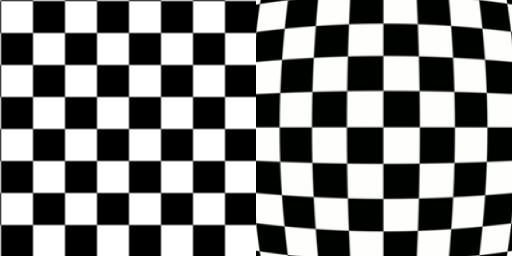|
Rectilinear Lens
In photography, a rectilinear lens is a photographic lens that yields images where straight features, such as the edges of walls of buildings, appear with straight lines, as opposed to being curved. In other words, it is a lens with little or no barrel or pincushion distortion. At particularly wide angles, however, the rectilinear perspective will cause objects to appear increasingly stretched and enlarged as they near the edge of the frame. These types of lenses are often used to create forced perspective effects. The most famous example is the Rapid Rectilinear Lens developed by John Henry Dallmeyer in 1866. It allowed distortionless photos to be taken quickly for the first time, and was a standard lens design for 60 years. As of 2020, the Laowa 9mm f/5.6 lens is the world's widest rectilinear lens for full frame cameras. The vast majority of video and still cameras use lenses that produce nearly rectilinear images. A popular alternative type of lens is a fisheye lens whi ... [...More Info...] [...Related Items...] OR: [Wikipedia] [Google] [Baidu] |
Photography
Photography is the art, application, and practice of creating durable images by recording light, either electronically by means of an image sensor, or chemically by means of a light-sensitive material such as photographic film. It is employed in many fields of science, manufacturing (e.g., photolithography), and business, as well as its more direct uses for art, film and video production, recreational purposes, hobby, and mass communication. Typically, a lens is used to focus the light reflected or emitted from objects into a real image on the light-sensitive surface inside a camera during a timed exposure. With an electronic image sensor, this produces an electrical charge at each pixel, which is electronically processed and stored in a digital image file for subsequent display or processing. The result with photographic emulsion is an invisible latent image, which is later chemically "developed" into a visible image, either negative or positive, depending on the ... [...More Info...] [...Related Items...] OR: [Wikipedia] [Google] [Baidu] |
Photographic Lens
A camera lens (also known as photographic lens or photographic objective) is an optical lens or assembly of lenses used in conjunction with a camera body and mechanism to make images of objects either on photographic film or on other media capable of storing an image chemically or electronically. There is no major difference in principle between a lens used for a still camera, a video camera, a telescope, a microscope, or other apparatus, but the details of design and construction are different. A lens might be permanently fixed to a camera, or it might be interchangeable with lenses of different focal lengths, apertures, and other properties. While in principle a simple convex lens will suffice, in practice a compound lens made up of a number of optical lens elements is required to correct (as much as possible) the many optical aberrations that arise. Some aberrations will be present in any lens system. It is the job of the lens designer to balance these and produce a desig ... [...More Info...] [...Related Items...] OR: [Wikipedia] [Google] [Baidu] |
Image Distortion
In geometric optics, distortion is a deviation from rectilinear projection; a projection in which straight lines in a scene remain straight in an image. It is a form of optical aberration. Radial distortion Although distortion can be irregular or follow many patterns, the most commonly encountered distortions are radially symmetric, or approximately so, arising from the symmetry of a photographic lens. These ''radial distortions'' can usually be classified as either ''barrel'' distortions or ''pincushion'' distortions. Mathematically, barrel and pincushion distortion are quadratic, meaning they increase as the ''square'' of distance from the center. In mustache distortion the quartic (degree 4) term is significant: in the center, the degree 2 barrel distortion is dominant, while at the edge the degree 4 distortion in the pincushion direction dominates. Other distortions are in principle possible – pincushion in center and barrel at the edge, or higher order ... [...More Info...] [...Related Items...] OR: [Wikipedia] [Google] [Baidu] |
Forced Perspective
Forced perspective is a technique that employs optical illusion to make an object appear farther away, closer, larger or smaller than it actually is. It manipulates human visual perception through the use of scaled objects and the correlation between them and the vantage point of the spectator or camera. It has uses in photography, filmmaking and architecture. In filmmaking An example of forced perspective is a scene in an action movie in which dinosaurs are threatening the heroes. By placing a miniature model of a dinosaur close to the camera, the director may make the dinosaur look monstrously tall to the viewer, even though it is just closer to the camera. Forced perspective had been a feature of German silent films and ''Citizen Kane'' revived the practice. Movies, especially B-movies in the 1950s and 1960s, were produced on limited budgets and often featured forced perspective shots. Forced perspective can be made more believable when environmental conditions obscure the ... [...More Info...] [...Related Items...] OR: [Wikipedia] [Google] [Baidu] |
Rapid Rectilinear
The Rapid Rectilinear also named Aplanat is a famous photographic lens design. The Rapid Rectilinear is a lens that is symmetrical about its aperture stop with four elements in two groups. It was introduced by John Henry Dallmeyer in 1866. The symmetry of the design greatly reduces radial distortion, improving on the Petzval lens. See also *Rectilinear lens In photography, a rectilinear lens is a photographic lens that yields images where straight features, such as the edges of walls of buildings, appear with straight lines, as opposed to being curved. In other words, it is a lens with little or no ... References * External links Rapid Rectilinear article Photographic lens designs {{photo-stub ... [...More Info...] [...Related Items...] OR: [Wikipedia] [Google] [Baidu] |
John Henry Dallmeyer
John Henry Dallmeyer (6 September 183030 December 1883), Anglo-German optician, was born at Loxten, Westphalia, the son of a landowner. On leaving school at the age of sixteen he was apprenticed to an Osnabrück optician, and in 1851 he came to London, where he obtained work with an optician, W Hewitt, who shortly afterwards, with his workmen, entered the employment of Andrew Ross, a lens and telescope manufacturer. Dallmeyer's position in this workshop appears to have been an unpleasant one, and led him to take, for a time, employment as French and German correspondent for a commercial firm. After a year he was, however, re-engaged by Ross as scientific adviser, and was entrusted with the testing and finishing of the highest class of optical apparatus. This appointment led to his marriage with Ross's second daughter, Hannah, and to the inheritance, at Ross's death (1859), of a third of his employer's large fortune and the telescope manufacturing portion of the business. Turning f ... [...More Info...] [...Related Items...] OR: [Wikipedia] [Google] [Baidu] |
Fisheye Lens
A fisheye lens is an ultra wide-angle lens that produces strong visual distortion intended to create a wide panoramic or hemispherical image. Fisheye lenses achieve extremely wide angles of view, well beyond any rectilinear lens. Instead of producing images with straight lines of perspective ( rectilinear images), fisheye lenses use a special mapping ("distortion"; for example: equisolid angle, see below), which gives images a characteristic convex non-rectilinear appearance. The term ''fisheye'' was coined in 1906 by American physicist and inventor Robert W. Wood based on how a fish would see an ultrawide hemispherical view from beneath the water (a phenomenon known as Snell's window). Their first practical use was in the 1920s for use in meteorology to study cloud formation giving them the name "whole-sky lenses". The angle of view of a fisheye lens is usually between 100 and 180 degrees, although lenses covering up to 280 degrees exist (see below). Their focal lengths d ... [...More Info...] [...Related Items...] OR: [Wikipedia] [Google] [Baidu] |
Wide-angle Lens
In photography and cinematography, a wide-angle lens refers to a lens whose focal length is substantially smaller than the focal length of a normal lens for a given film plane. This type of lens allows more of the scene to be included in the photograph, which is useful in architectural, interior and landscape photography where the photographer may not be able to move farther from the scene to photograph it. Another use is where the photographer wishes to emphasise the difference in size or distance between objects in the foreground and the background; nearby objects appear very large and objects at a moderate distance appear small and far away. This exaggeration of relative size can be used to make foreground objects more prominent and striking, while capturing expansive backgrounds. A wide angle lens is also one that projects a substantially larger image circle than would be typical for a standard design lens of the same focal length. This large image circle enables either ... [...More Info...] [...Related Items...] OR: [Wikipedia] [Google] [Baidu] |
Rectilinear Grid
A regular grid is a tessellation of ''n''-dimensional Euclidean space by congruent parallelotopes (e.g. bricks). Its opposite is irregular grid. Grids of this type appear on graph paper and may be used in finite element analysis, finite volume methods, finite difference methods, and in general for discretization of parameter spaces. Since the derivatives of field variables can be conveniently expressed as finite differences, structured grids mainly appear in finite difference methods. Unstructured grids offer more flexibility than structured grids and hence are very useful in finite element and finite volume methods. Each cell in the grid can be addressed by index (i, j) in two dimensions or (i, j, k) in three dimensions, and each vertex has coordinates (i\cdot dx, j\cdot dy) in 2D or (i\cdot dx, j\cdot dy, k\cdot dz) in 3D for some real numbers ''dx'', ''dy'', and ''dz'' representing the grid spacing. Related grids A Cartesian grid is a special case where the elements are ... [...More Info...] [...Related Items...] OR: [Wikipedia] [Google] [Baidu] |
Rectilinear Projection
Rectilinear means related to a straight line; it may refer to: * Rectilinear grid, a tessellation of the Euclidean plane * Rectilinear lens, a photographic lens * Rectilinear locomotion, a form of animal locomotion * Rectilinear polygon, a polygon whose edges meet at right angles * Rectilinear propagation, a property of waves * Rectilinear Research Corporation, a now defunct manufacturer of high-end loudspeakers * Rectilinear style, the third historical division of English Gothic architecture * Rectilinear motion or linear motion is motion along a straight line * Rectilinear prophecy, where a straight line can be drawn from the prophecy to the fulfillment without any branches as in the case of typological interpretations * Near-rectilinear halo orbit A near-rectilinear halo orbit (NRHO) is a halo orbit with slightly curved – or nearly straight – sides between close passes with an orbiting body. The 2022 CAPSTONE mission is the first such orbit in cislunar space, and this ... [...More Info...] [...Related Items...] OR: [Wikipedia] [Google] [Baidu] |
Nikkor 13mm F/5
Nikkor is the brand of lenses produced by Nikon Corporation, including camera lenses for the Nikon F-mount. Nikko parent company brand, from which the Nikkor brand evolved. The ''Nikkor'' brand was introduced in 1932, a Westernised rendering of an earlier version ''Nikkō'' (日光), an abbreviation of the company's original full name ''Nippon Kōgaku'' ("Japan Optics"; 日本光学工業株式会社).The 75th Anniversary of NIKKOR Lenses'' (''Nikkō'' also means "sunlight" and is the name of a Japanese town.) In 1933, Nikon marketed its first camera lens under the Nikkor brand name, the "Aero-NIKKOR," for aerial photography. Nikon originally reserved the Nikkor designation for its highest-quality imaging optics, but in recent history almost all Nikon lenses are so branded. Notable Nikkor branded optics have included: * F-mount lenses for 35mm SLR and DSLR photography. For a full list see Nikon F-mount. * 1 mount lenses for Nikon CX format currently used by Nikon 1 series. * ... [...More Info...] [...Related Items...] OR: [Wikipedia] [Google] [Baidu] |







